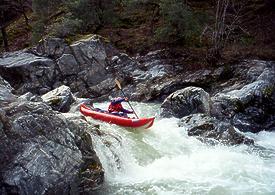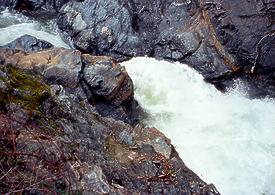|
Elk Creek into the Klamath River |
Elk Creek offers what appears to be a classic steep creek run, perhaps by itself worth the drive to the Klamath area. Lars Holbek rightfully included this run in his 3rd edition, based on a description by his brother Suren, who ran the lower 5 miles with Leif Hansen at very low flows. To lengthen the run, we drove a ways further upstream to put in. After a while we started to think there was more water than we wanted, so we abandoned our run at a spouting waterfall, walking back up to the road. Only later did we realize that Cassady/Calhoun's 3rd edition points out that this is a 13 mile run, with waterfalls, starting way upstream at Sulphur Springs USFS campground! That would make Elk Creek even more worthwhile than what we saw in the short distance we boated.
To reach take-out from I-5, drive east and then south on highway 96 until you reach Happy Camp. Cross the river on a bridge, turn right on Elk Creek Road, and quickly bear right on Curley Jack Road, which after a a distance crosses Elk Creek. A gravel bar and beach there offers a good take-out. To reach put-in from there, return to Elk Creek Road, turn sharp right, and climb the hill above the creek. After about 4 miles the road crosses from the east bank to the west bank. Continue upstream to the USFS campground at Sulphur Springs.
I was never a big fan of the Klamath area until discovering its sidecreeks. Boaters could spend an entire week touring the Creeks o' Klamath, as they might be called in an advertising brochure. Indian Creek, along with lower Clear Creek, are apparently two of the easier class III runs. Elk Creek and upper Clear Creek are more difficult class IV+ runs, and Lars Holbek rates Bluff Creek as class V-VI. Working downstream from I-5 to Happy Camp, the following creeks represent undocumented and perhaps undiscovered runs: Humbug Creek, Lumgrey Creek, Beaver Creek, Little Humbug Creek, Barkhouse Creek, Doggett Creek (no road nearby), McKinney Creek, Horse Creek, the (well-known) Scott River, O'Neil Creek (no road), Walker Creek (no road), Seiad Creek, Grider Creek, Portuguese Creek (no road), Fort Goff Creek (no road), Thompson Creek (no road), and another Horse Creek. From Happy Camp down to the Salmon confluence, the following creeks are encountered: Indian Creek (III+ 1P), Elk Creek (IV+ Ps), Oak Flat Creek (no road), Clear Creek (IV+ then III), Independence Creek (no road), King Creek (no road), Ukonom Creek (trail access), Swillip Creek (no road), Dillon Creek (no road), Ti Creek (no road), Sandy Bar Creek (no road), Stanshaw Creek (no road), Irving Creek (no road), and Rogers Creek (no road nearby). From the Salmon River down to the Trinity confluence, the following creeks are encountered: Perch Creek (no road), Wilder Creek (no road nearby), Cap Creek (good road access), Slate Creek (no road), Bluff Creek (described in Holbek's 3rd edition), and Hopkins Creek (no road). Below the Trinity confluence, these creeks are worth investigating: Pine Creek, Tully Creek (no road), Tectah Creek (no road nearby), Blue Creek (the largest drainage, starting in Klamath National Forest), and Turwar Creek (no road).
|
Creeks NavigationHomeRecommended Runs Map of Rivers Alphabetic Index Alphabetic Table Text Search
Sponsored Links
|

